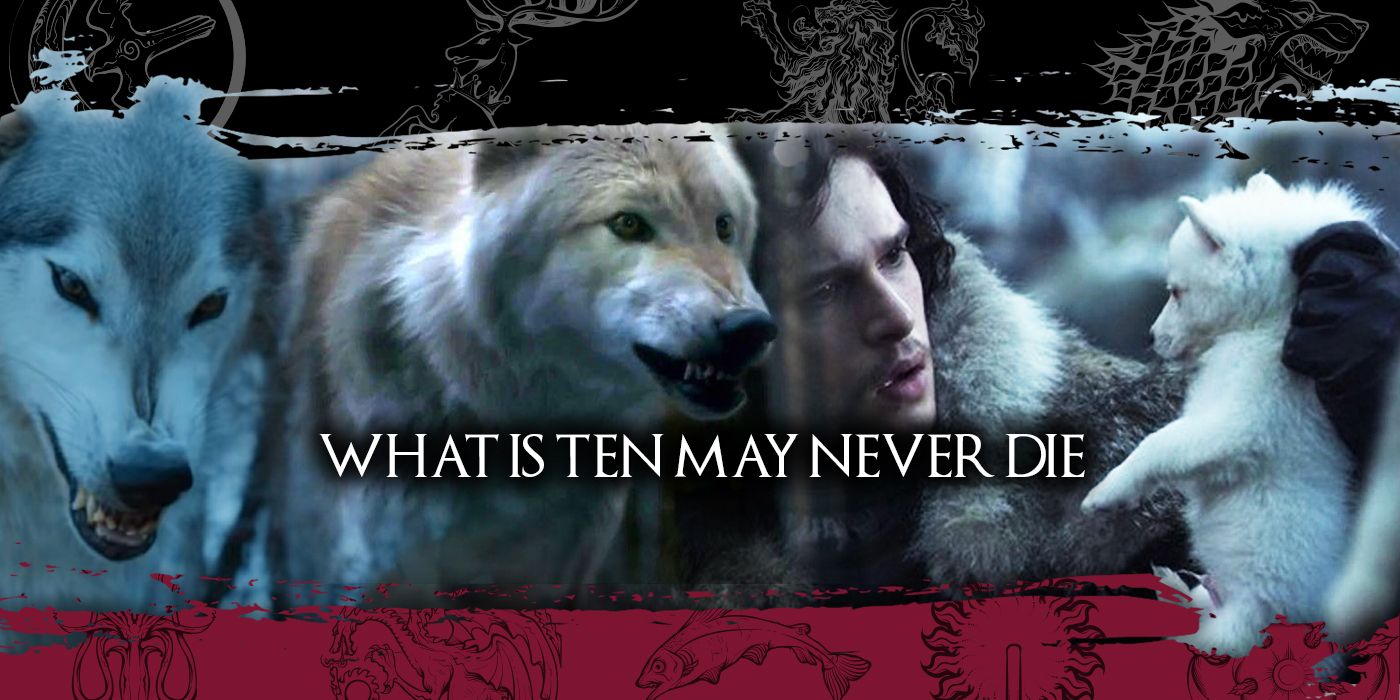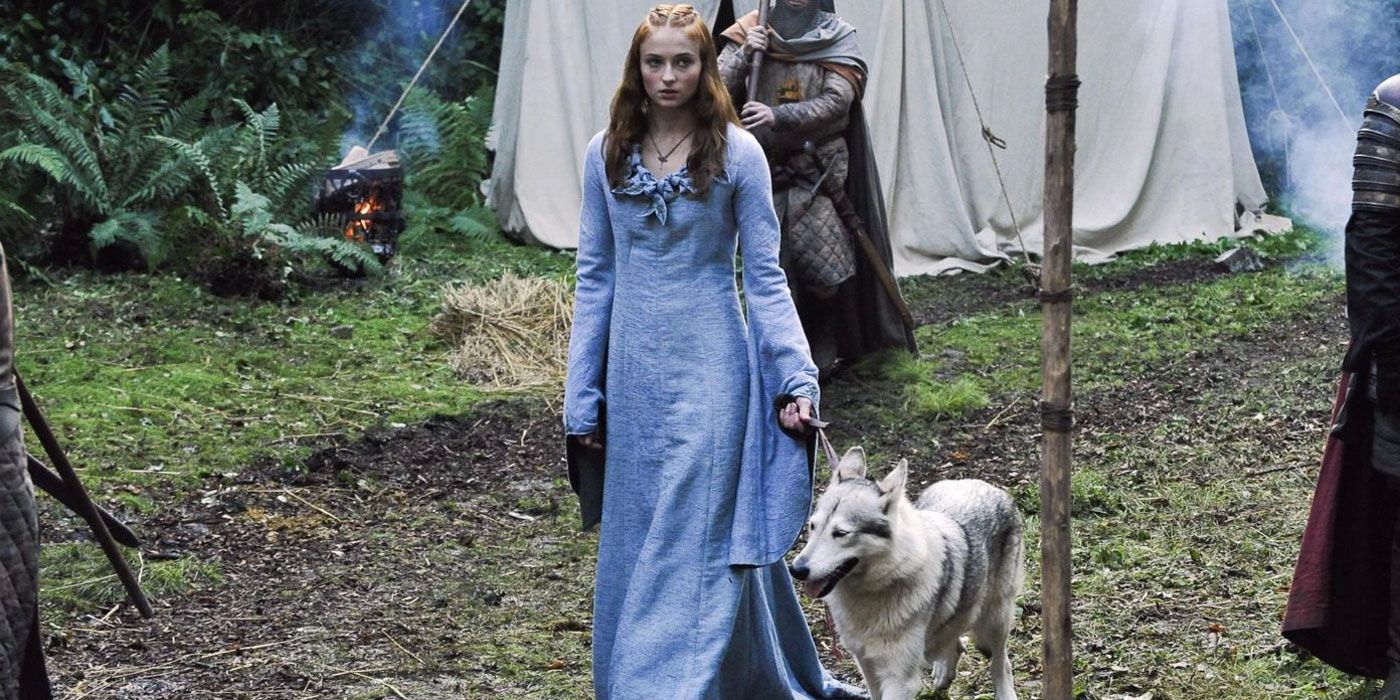On April 17, 2011, a new HBO drama about warring families, icy zombies, and CGI dragons premiered, and whether you loved it or hated it, there's simply no denying the kind of impact Game of Thrones had not just on television, not just on pop culture, but on the world in general. Its epic journey was a wild, weird, and fascinating adventure, and to mark the occasion Collider presents "What Is Ten May Never Die," a ten-week retrospective on the show's legacy — what we remember fondly, what we wish we could forget, and everything in between.
Most fathers don't give their children puppies with this loving refrain: "Train them yourselves, feed them yourselves, and if they die, you'll bury them yourselves." But then, right from the beginning of Game of Thrones, it's clear that Ned Stark (Sean Bean) is not a typical TV dad, and the puppies he bestows on his six children in the pilot episode will not grow up to be your typical sort of pet.
The direwolves were a big part of the show's iconography from the first episode, in part because this mythical species of canine was the designated symbol of the Stark family. But beyond the family's flag, direwolves represented not just an early touch of the magic that would soon dominate the narrative. For, when you look at the show's treatment of the show's direwolves, what's fascinating is how they end up serving as a microcosm of both the best and worst qualities of Game of Thrones.
In "Winter Is Coming," Ned and several of the younger Starks are returning home after a day's hard work of deserter-beheading when they come across a dead direwolf in the woods. Ned's first inclination is to put her orphaned pups out of their misery, but Jon Snow (Kit Harington) convinces him to instead give them to the Stark children, since there are five puppies and five Starks. (As the Stark family bastard, Jon is given the albino runt discovered moments later.)
Right away, scenes involving the Stark direwolves offer notable insight into the show beyond the surface. For example, Theon's (Alfie Allen) behavior in the scene where the puppies are discovered is a pretty perfect encapsulation of the character flaws which will eventually lead him towards his awful future: Quick to judge the direwolf as a "freak" at first sight, he immediately leaps forward to kill the puppy Bran has been cradling after Ned says they'd best be put out of their misery. He's a boy yearning to feel like a real man, lacking the inner strength and integrity to follow his own righteous path, and those qualities will contribute to his not-exactly-unexpected downfall.
But it's the second episode of the series, "The Kingsroad," where their power as a part of the storytelling stands out — specifically, to confirm for the viewer that anyone can die at any time, and often for totally unjust reasons. In the episode, King Robert (Mark Addy), the Lannister clan, Ned Stark, and Ned Stark's daughters are road-tripping from the North to King's Landing, and during a pit stop a drunk Prince Joffrey (Jack Gleeson) gets into a scrape with Arya Stark (Maisie Williams) and Mycah the butcher's boy (Rhodri Hosking). Joffrey's bullying gets cut short when Arya's direwolf Nymeria attacks him, but that moment of vengeance means that not only does Arya have to chase away her pet to protect her, but in retribution the King and Queen Cersei (Lena Headey) have Mycah killed and demand the death of Sansa's direwolf Lady.
I've seen this show from beginning to end several times, witnessed so much bloody carnage across these 73 episodes. But during this latest rewatch of "The Kingsroad," I once again skipped forward the necessary 30 seconds to avoid watching Ned honor his vow to serve his king by killing his daughter's beloved pet. It's the aching, trusting way that the tethered Lady looks at Ned Stark as he approaches her with a knife which makes this sequence impossible to watch — that, and Ned's reason for doing the deed in the first place, his faith in the code of loyalty and fealty being the same faith that will get his dumb ass killed before the end of the season.
Killing a dog on screen is a taboo that can upset some viewers so much they'll refuse to watch — even if it's a film like John Wick, where the whole point of the dog's death is to kick off the titular character's bloody revenge against... wow, Alfie Allen again! Guess the guy found a niche.) Still, everything about this plot point feels essential to understanding Ned Stark as a person, the Baratheons and Lannisters as rulers, and Westeros as a country.
At that point in Game of Thrones, Lady's death was awful — while the actual act happens basically off-screen, those awful noises of puppy murder are hard to forget — but it doesn't feel exceptionally gratuitous... At least, in comparison to what was to come. As the show grew more and more bloodthirsty, the direwolves met nastier ends: Grey Wind was killed by the same men who killed his human companion during the Red Wedding, and was decapitated to create the gruesome visual of his head mounted on Robb Stark's body; Shaggydog also got decapitated when Rickon Stark was captured; Bran's beloved Summer saved his boy's life one last time by sacrificing himself to the wights at the cave of the Three-Eyed Raven.
Nymeria's escape in "The Kingsroad" is also an important detail for the show, as it represents another quintessential Game of Thrones quality — specifically, the introduction of dangling plot threads that would never be wrapped up in a satisfying way. For years, the question of whether or not Nymeria would ever reappear was bandied about, and was only resolved in Season 7, when Arya encounters her former pet in the wild, leading a pack of non-dire-y wolves — a letdown of a reveal that made us question why we ever cared to begin with, and a very common emotion to feel during the final years of the series.
And then there's Ghost, the only other Stark direwolf to survive to the end of the series. While Ghost appeared in all eight seasons of the show, he was more often than not an afterthought, his diminished presence in part driven by the fact that filming a doggo the size of a pony (as full-grown direwolves become) is a pretty expensive visual effect — but also driven by the fact that like many other characters on this show, the showrunners simply didn't know what to do with them.
Really, these six puppies discovered in the pilot episode represent so much about how the show captured our attention and earned our frustration, whether they were brutally cut down to illustrate the cruelty of George R.R. Martin's brand of storytelling, casually murdered as collateral damage, or forgotten about entirely.
Game of Thrones is streaming now on HBO Max.


